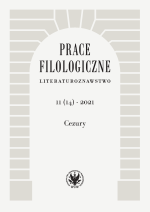„Życie sieroty” Jana Barszczewskiego − czarny romantyzm spoza modelu „antagonizmu wieszczów”
“Życie sieroty” by Jan Barszczewski − Dark Romanticism Beyond the Model of “Antagonism of Bards”
Author(s): Jarosław Mariusz ŁawskiSubject(s): Language and Literature Studies, Studies of Literature
Published by: Wydawnictwa Uniwersytetu Warszawskiego
Keywords: dark Romanticism; Jan Barszczewski; antagonism of bards; interpretation; Życie sieroty [The Life of An Orphan]; czarny romantyzm; Jan Barszczewski; antagonizm wieszczów; interpretacja; Życie sieroty
Summary/Abstract: The article presents the readers with a long forgotten drama Życie sieroty [The Life of An Orphan] by Jan Barszczewski (1780−1851), an outstanding Polish Romantic literature classic who produced his literary work in Saint Petersburg, Russia, Belarus, the former territory of Poland, and Cudowno, Ukraine. Barszczewski is the one who invented a unique model of referring to both the poetics of Dziady [Forefathers’ Eve] by Adam Mickiewicz and Godzina myśli [Hour of Thought] by Juliusz Słowacki. He consistently manages to refer to both of the great Polish Romantics avoiding any ‘antagonisms’ or juxtapositions of the bards whatsoever. Also, he successfully makes these references become a part of his dark and gloomy vision of the world. This literary phenomenon is at the same time one of the earliest examples of how artfully a poet can resort to inspirations of both authority figures of Polish Romanticism. What makes Barszczewski’s world consistent is his gloom-ridden and obscure vision of the cosmos where the ultimate consolation, in a metaphysical and afterlife sense, is religion − Roman Catholicism in its Easter Rite Catholic form.
Journal: Prace Filologiczne. Literaturoznawstwo [PFLIT]
- Issue Year: 2021
- Issue No: 11 (14)
- Page Range: 349-363
- Page Count: 15
- Language: Polish

